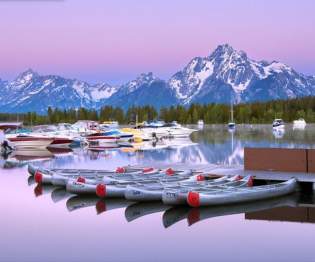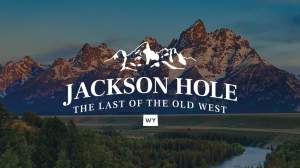Grand Teton National Park
Established in 1929 to preserve its natural beauty for future generations, Grand Teton National Park lies in the scenic mountain valley of Jackson Hole and encompasses nearly 310,000 acres of pristine wilderness.
Known worldwide for the jagged Teton Range and the towering 13,770-ft Grand Teton, the park also features numerous lakes, canyons, valleys, and miles of hiking trails through alpine terrain. Cascade Canyon, Paintbrush Canyon, and Death Canyon are among the most popular trails.
To view the park from canoe, kayak or boat, explorers may visit one of the many lakes that lie beneath the Tetons including Jenny Lake, Leigh Lake, Bradley Lake, Taggart Lake, and Phelps Lake. Jackson Lake, the largest in the park, also offers impressive views of Mount Moran, a massive granite mountain standing at 12,605 feet.
Things To Do in Grand Teton National Park
A popular destination for kayaking, whitewater rafting, and fly-fishing, the scenic Snake River meanders through the entire length of the park offering opportunities for both adventure and relaxation.
Roads in GTNP provide non-stop scenic views of the Teton Range with ample pullouts perfect for capturing unforgettable vistas on film.
Wildlife enthusiasts will discover the park is also home to over 1,000 plant species, 300 bird species, and 60 species of majestic mammals including bison, elk, moose, mule deer, pronghorn antelope, and both black and grizzly bear who are even more commonly spotted in nearby Yellowstone Park to the north.
Grand Teton National Park Lodging
Located just a few miles south of Grand Teton National Park, the town of Jackson, WY has numerous overnight options from historic old-west boutique hotels to luxurious spa accommodations. For those looking for lodging within the park, the Grand Teton Lodge Company offers unique stays to travelers with Jackson Lake Lodge, Jenny Lake Lodge, Flagg Ranch, and Colter Bay Village. Signal Mountain Lodge also features lakefront views while several rustic guest ranches provide visitors an authentic touch of the old west in the shadow of the Teton Mountains.
Adventurous GTNP visitors who wish to sleep under the stars are invited to explore the five National Park Service campgrounds found within the park. Campgrounds are first come, first served, and tend to fill quickly in warmer summer months, sometimes as early as 8AM. The popular Jenny Lake campground is among the busiest spots to camp while more remote Gros Ventre campground is among the least busy.
Both the Grand Teton Association and the National Parks Conservation Association provide more information about park programs and education. Grand Teton Association inspires deeper connection, better understanding, and enduring support for our public lands. Over a million members and supporters strong, the National Parks Conservation Association is the voice of America’s national parks.
Ready to join the Chamber? Need more information? Explore our Explorer Magazine Travel Planner, which you can also explore electronically HERE. If you're already here, feel free to stop by one of our Visitor Centers where an experienced agent will be able to guide you in the right direction.





